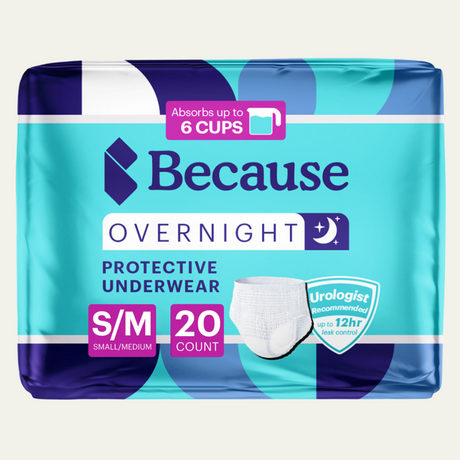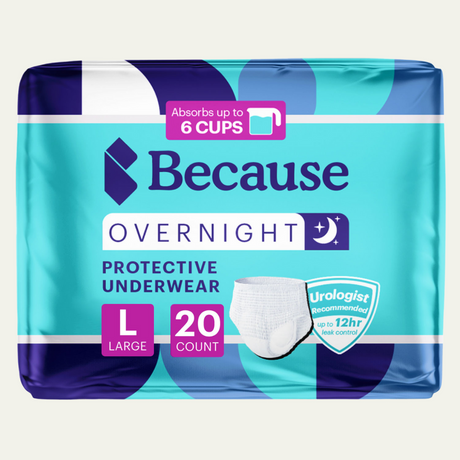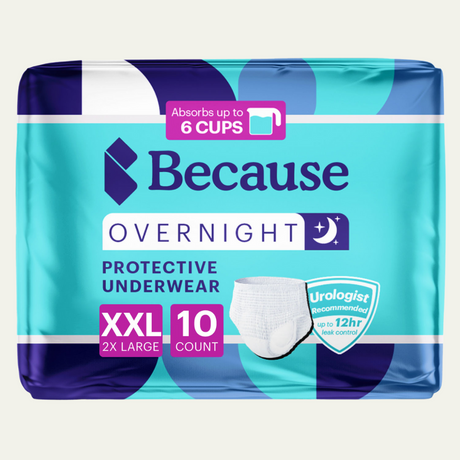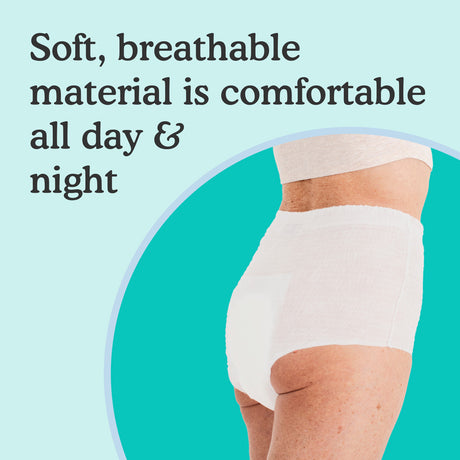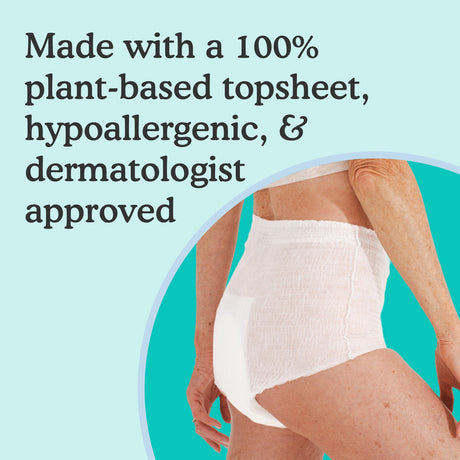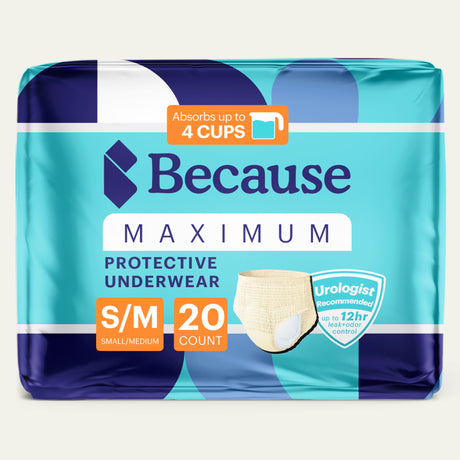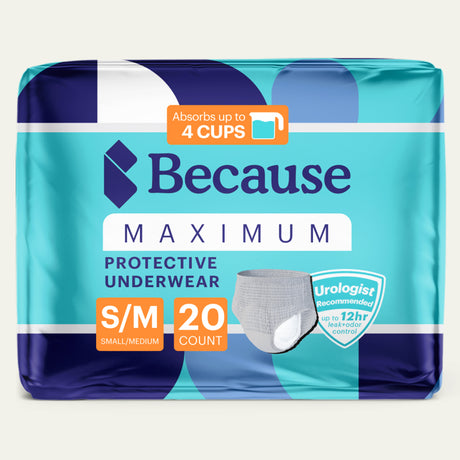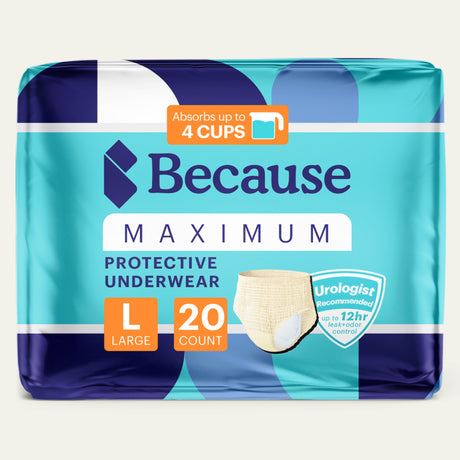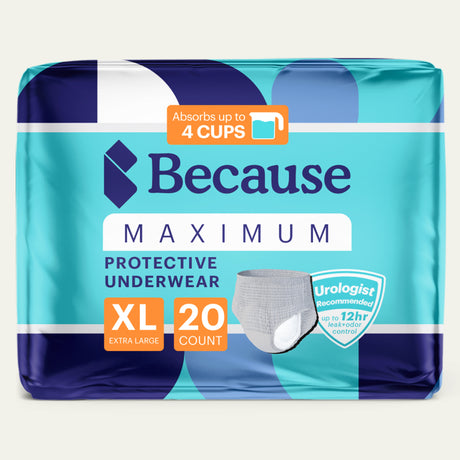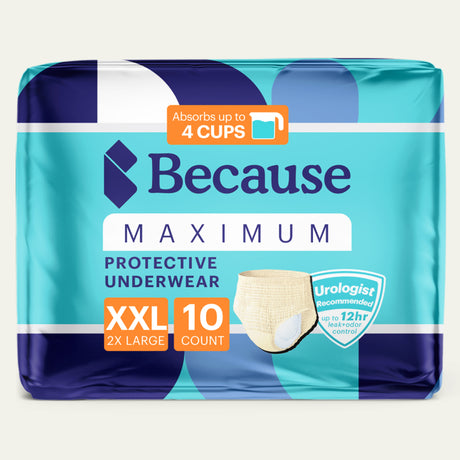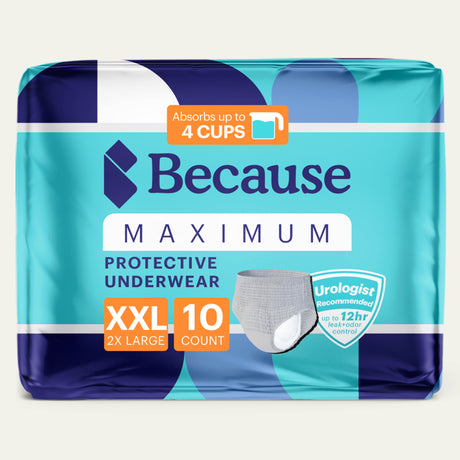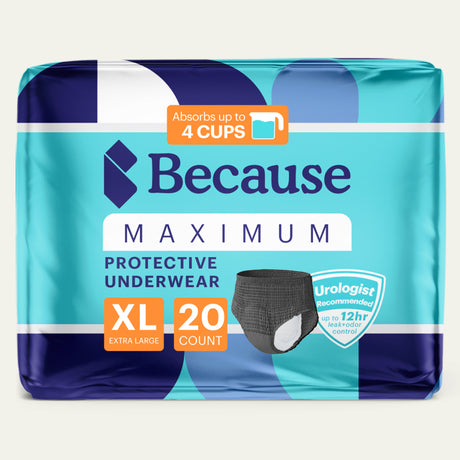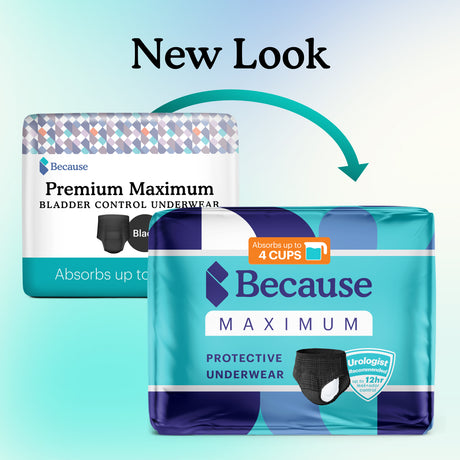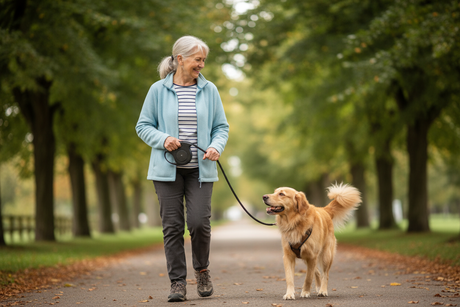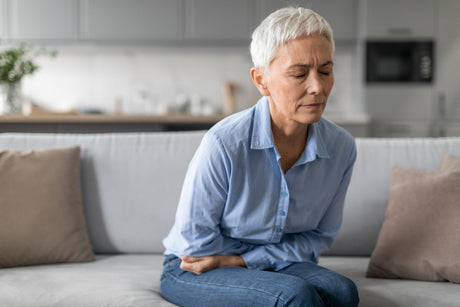Around 4 million adults in the U.S. suffer from fibromyalgia. The condition can cause widespread pain and fatigue as well as less commonly discussed symptoms. If you have fibromyalgia and experience bladder problems, you may wonder if there is a link between the two. Read on to learn more about the connection between incontinence and fibromyalgia and what you can do about bladder symptoms.

Can Fibromyalgia Cause Incontinence?
Studies have uncovered a potential link between fibromyalgia and incontinence. In one research study, 93% of surveyed patients who had fibromyalgia also experienced symptoms of overactive bladder, a common form of urinary incontinence, and researchers have found a relatively high prevalence of other types of bladder issues in people with fibromyalgia.
Although scientific research shows there is an association between overactive bladder and other types of incontinence, there isn’t enough evidence to prove that the chronic condition is a major contributing cause of bladder problems.
It could be that both incontinence and fibromyalgia are both caused by something else, like an immune system problem, or that some treatment options for fibromyalgia lead to bladder dysfunction.
Another possibility is that the urological association with fibromyalgia may be a coincidence. Women are more likely to develop fibromyalgia, and incontinence in women is also twice as common as incontinence in men. The fact that being a woman is one of the risk factors for both conditions could explain the connection.
Until further research like a large systematic review occurs, we don’t know enough to say for certain if the condition itself, or a medication used to treat it, is the cause of fibromyalgia incontinence.

Understanding Fibromyalgia
Fibromyalgia or FM is a condition that causes long-term pain. Although this chronic pain can occur everywhere, many people with fibromyalgia experience it in their arms, legs, chest, head, abdomen, back, and buttocks. Other common symptoms of fibromyalgia include sleep disorders and chronic fatigue. Some individuals with the condition also report joint pain and stiffness, numbness in the extremities, problems concentrating, digestive problems, and sensitivity to odors, noise, light, and/or temperature.
Unfortunately, health care providers don’t fully understand what the exact cause of fibromyalgia is. One theory is that the condition occurs due to muscle, joint, or nerve damage. Another is that the condition may be a neurological disorder that happens when a person is hypersensitive to pain.
Genetics may play a role, as people who have relatives with the condition are more likely to develop fibromyalgia themselves. There is also evidence to suggest that diseases associated with chronic pain, like rheumatoid arthritis, and mental health issues, like depression and anxiety disorders, may contribute to fibromyalgia.
Types of Incontinence Associated with Fibromyalgia
There are several types of incontinence, and certain ones are more commonly associated with fibromyalgia. Let’s take a look at them one by one.
Stress Incontinence
Stress incontinence is a type of urinary incontinence that occurs when muscles in the pelvic area called the pelvic floor become weakened. These muscles are responsible for supporting reproductive and digestive organs as well as the lower urinary tract. When they grow weak, they can no longer properly support the bladder, making it possible for urine to escape.
People with stress incontinence may experience urine leakage when pressure gets applied to the pelvic area. Symptoms may arise when they sneeze, cough, laugh, exercise, or lift heavy objects.
Urge Incontinence
Urge incontinence occurs when the nerves that control the bladder don’t work properly. As a result, bladder muscle contractions happen irregularly, causing a sudden, intense urge to urinate.
Overactive bladder syndrome is one form of urge incontinence that usually occurs due to abnormal nerve signals in the bladder area. In addition to an urgent need to urinate, overactive bladder symptoms include urinary frequency and waking up to go to the bathroom more than twice per night.
Fecal Incontinence
Fecal incontinence is when a person is unable to control their bowel movements. Individuals with fecal incontinence may experience leakage or a complete loss of bowel control. It can occur due to muscle or nerve damage, neurological conditions, constipation, diarrhea, hemorrhoids, and structural problems with the digestive organs.

The Connection Between Fibromyalgia and Incontinence
Earlier, we touched on some of the ways that fibromyalgia syndrome and incontinence may be connected. Now, let’s dive into these potential links more deeply.
Central Nervous System Dysfunction
As previously mentioned, one theory about fibromyalgia is that it occurs due to nervous system dysfunction. It’s possible that the same abnormal nerve stimulation that causes people with the condition to feel the pain associated with fibromyalgia may also trigger the muscle contractions that lead to the presence of overactive bladder symptoms.
Weakened Pelvic Floor Muscles
Many people with fibromyalgia report muscle weakness and stiffness. Another theory about fibromyalgia incontinence holds that changes in the muscles that occur due to the condition may result in pelvic floor weakness. This could explain why people with fibromyalgia develop stress incontinence.
Coexisting Medical Conditions
Certain medical conditions are common in people who have fibromyalgia, and some of these can cause incontinence. These conditions include the following.
Interstitial Cystitis (IC)
Interstitial cystitis or IC is chronic pelvic pain and low back pain that doesn’t have an identifiable medical cause. The unexplained bladder pain associated with IC is similar to the symptoms of urinary tract infections (UTIs). In fact, this bladder pain may be incorrectly diagnosed as a UTI in some cases.
Individuals with IC often experience an urgent need to urinate, frequent urination, and chronic pain. These lower urinary symptoms can lead to incontinence.
Irritable Bowel Syndrome (IBS)
Irritable bowel syndrome or IBS is a chronic digestive disorder that can cause abdominal pain, cramping, and bloating. Additionally, people with IBS may experience frequent bouts of constipation and/or diarrhea. Both of these symptoms can lead to fecal incontinence.
Endometriosis
Endometriosis is a condition where cells that ordinarily make up the lining of the uterus begin to grow in other areas. Most often, the cells develop in other parts of the female reproductive system like the ovaries and fallopian tubes. However, they may also occur in the urinary tract. When the cells form lesions in this area, it can lead to lower urinary tract symptoms like pain and incontinence.
Side Effects of Fibromyalgia Medications or Treatments
Prescription medication commonly prescribed for fibromyalgia may be responsible for urinary distress and incontinence in some people. Gabapentinoids, like gabapentin and pregabalin, may cause the sphincter muscles that keep urine contained in the bladder to relax too much, allowing fluid to escape. Selective serotonin reuptake inhibitors (SSRIs) like fluoxetine, paroxetine, and sertraline have the potential to cause urinary incontinence as well.

Fibromyalgia and Frequent Urination at Night
Urinary incontinence isn’t the only bladder issue associated with fibromyalgia. Individuals who have the condition may also be more at risk for developing nocturia or frequent urination at night. One study of 285 subjects in Norway found that 89 to 92% of people with fibromyalgia also had nocturia. As with incontinence, more research is necessary to determine whether fibromyalgia is the direct cause of frequent urination at night.
Practical Tips for Managing Fibromyalgia Incontinence
Although there is no cure for fibromyalgia, there are things that you can do to manage incontinence associated with the condition. Read on for more information about coping with the effects of fibromyalgia incontinence on your daily life.

Use Bladder Protection and Incontinence Care Products
Incontinence protection products can help you stay dry and feel confident in social settings and during outings. Here are some products to consider:
- Incontinence pads: An incontinence pad is protection that you wear inside your own underwear. Its absorbent material captures urine and locks it away to prevent leaks.
- Incontinence underwear: Also called diapers, incontinence underwear is an alternative to traditional underwear made out of absorbent material that stops leaks.
- Cleansing products: If you have fibromyalgia incontinence, cleansing your private area with a cleansing spray or wipes can help to control incontinence odors and promote healthy skin.
- Barrier cream: People with incontinence are at risk for adult diaper rash, skin irritation that occurs due to moisture exposure. A barrier cream helps to seal out moisture to reduce the risk of irritation.
In some cases, health insurance may help cover the cost of incontinence products if your doctor writes a prescription and states that they are medically necessary. Contact your insurer for more information.
Strengthen the Pelvic Floor with Exercises and Physical Therapy
Like other muscles of the body, the pelvic floor can be strengthened through regular exercise. Often, doctors recommend that people with incontinence perform Kegel exercises, which involves tensing the pelvic floor muscles. A physical therapist can help you learn the proper technique and introduce you to other exercises that may reduce both fibromyalgia and incontinence symptoms.
Practice Bladder and Bowel Training
Specialists sometimes suggest bladder and bowel training for people dealing with fibromyalgia incontinence. With bladder and bowel training, you go to the bathroom at specific times of day, whether or not you have the urge to urinate or move your bowels. Over time, your body may adjust to this schedule, making leaks and accidents less likely to occur.
Make Lifestyle Changes
Making changes to your lifestyle could help you better manage incontinence. The following are some modifications that may be beneficial:
- Limit your intake of alcohol and caffeine.
- Eat fewer fatty, acidic, and spicy foods, like citrus fruits and fried foods, as they can cause bladder irritation.
- Exercise regularly.
- Lose weight if you need to, or take steps to maintain a healthy weight.
- Join support groups to talk about your experiences and make incontinence less of a taboo subject.
 Try Supplements for Incontinence
Try Supplements for Incontinence
Bladder health supplements can complement lifestyle changes and other interventions for incontinence. Containing pumpkin seed and soy germ, Because Bladder Control Supplement has been clinically shown to decrease incontinence symptoms like urinary frequency.
Talk to Your Doctor About Medical Interventions for Incontinence
The information outlined in this post is not intended to be a substitute for medical advice. If you have fibromyalgia incontinence, talk to your healthcare provider about treatment options, which may include:
- Wearable devices: Your doctor may recommend a vaginal pessary device, a plastic device that fits inside of the vagina to support the bladder, and/or urethral inserts, which are small tampon-like devices worn inside the urethra to absorb leaks.
- Medications: A number of medications have been approved for the treatment of overactive bladder. They include oxybutynin, trospium, solifenacin, fesoterodine and mirabegron.
- Botox: Injections of Botox into the bladder muscle has been shown to reduce muscle contractions and ease urge incontinence symptoms in some people.
- Urethral bulking agents: Bulkamid and other injectables can strengthen the urethra to reduce leaks in people with stress incontinence.
- Surgical procedures: There are a number of surgeries that can be performed to address stress and urge incontinence symptoms. Examples include the sling procedure, where a surgeon creates a sling out of tissue or mesh to support the bladder, and sacral nerve stimulation, which involves implanting an electrical device at the base of the spine to stimulate the bladder nerves.
Do you or a loved one struggle with fibromyalgia incontinence? Take our bladder protection quiz and get a sample pack to try.
If you're struggling with incontinence, join one of our private support groups today!
Women's Incontinence Support Group
Men's Incontinence Support Group
Sources:
Centers for Disease Control and Prevention. (2021). Fibromyalgia. Retrieved from https://www.cdc.gov/arthritis/types/fibromyalgia.htm
Coppieters, I., Barbier, M., et al. (2020). Fibromyalgia and widespread pain: Is there a key role for peripheral neuropathy? Pain Medicine, 21(12), 3476-3490. doi: 10.1093/pm/pnaa292
Office of Research on Women's Health. (n.d.). Urinary incontinence. Retrieved from https://orwh.od.nih.gov/research/maternal-morbidity-and-mortality/information-for-women/urinary-incontinence
Landmark, T., Romundstad, P., et al. (2005). Association of migraine and fibromyalgia: A population-based study. BMC Neurology, 5(1), 20. doi: 10.1186/1471-2377-5-20


